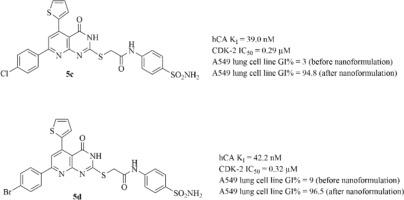利用杂环融合嘧啶创新设计和合成双作用hCA IX/CDK-2抑制剂,用于尖端抗癌治疗:玉米蛋白纳米颗粒用于体内肺癌治疗
IF 4.7
2区 医学
Q1 BIOCHEMISTRY & MOLECULAR BIOLOGY
引用次数: 0
摘要
双靶点策略有望提高癌症治疗效果。据此,合理设计并合成了一系列融合嘧啶类似物(5a-h和8a-f),作为碳酸酐酶IX (hCA IX)和细胞周期蛋白依赖性激酶2 (CDK-2)的潜在抑制剂。酶抑制结果表明,化合物5c和5d具有较强的抑制活性,IC50值分别为0.29 μM和0.32 μM, KI值分别为39 nM和42.2 nM。不幸的是,化合物5c和5d对A549癌细胞的抑制作用(分别为3%和9%)显示出不太好的细胞生长抑制作用(GI%)。令人印象深刻的是,他们的玉米蛋白纳米颗粒(NPs)显著提高了GI%,分别达到94.8%和96.5%。纳米配方5c和5d显著诱导肺癌细胞凋亡,导致总凋亡率分别为对照组的62.35%和62.7%,分别为17.2%。基因表达显示凋亡相关基因P53、Bax和caspases 3,8,9显著上调;而抗凋亡基因Bcl-2在A549癌细胞中表达下调。此外,研究了5c@Zein NPs和5d@Zein NPs的平均粒径、多分散性指数(PDI)、zeta电位和包封效率(EE%)。两种配方的单分散纳米颗粒粒径分别为151.6±9.2 nm和162.4±10.7 nm, zeta电位值分别为- 30.9±1.8 mV和- 24.6±2.1 mV。此外,5c和5d在玉米蛋白NPs内被高度包裹,并表现出ph触发的体外释放方式。验证体内癌症模型,5c-Zein NPs通过降低肺指数和抑制CDK-2和hCA IX蛋白显著改善了诱导的变化。此外,分子对接研究揭示了化合物5c和5d在hCA IX和CDK-2的结合口袋内特异性和有利的相互作用,这支持了它们作为双靶点抑制剂的潜力。本文章由计算机程序翻译,如有差异,请以英文原文为准。

Innovative design and synthesis of dual-acting hCA IX/CDK-2 inhibitors through hetero ring fused pyrimidine utilization for cutting-edge anticancer therapy: Zein nanoparticles for in vivo lung cancer treatment
A dual-targeting strategy is anticipated to enhance cancer therapy efficacy. Accordingly, a series of fused pyrimidine analogues (5a-h and 8a-f) was rationally designed and synthesized as potential inhibitors towards carbonic anhydrase IX (hCA IX) and cyclin-dependent kinase-2 (CDK-2). The enzyme inhibition results revealed that compounds 5c and 5d exhibited potent inhibitory activity, with IC50 values of 0.29 μM and 0.32 μM and KI values of 39 nM and 42.2 nM, respectively. Unfortunately, compounds 5c and 5d revealed non-promising cell growth inhibition (GI%) against A549 cancer cells (3 % and 9 %, respectively). Impressively, their Zein-nanoparticles (NPs) significantly promoted the GI% to 94.8 % and 96.5 % respectively. The nanoformulations of 5c and 5d significantly induced apoptotic lung cancer cell death, leading to total apoptosis that was 62.35 % and 62.7 % of the control, 17.2 %, respectively. Gene expressions revealed significant upregulation of apoptosis-associated genes P53, Bax, and caspases 3, 8, 9; however, the anti-apoptotic gene Bcl-2 was downregulated in the A549 cancer cells. In addition, the average particle sizes, polydispersity index (PDI), zeta potential, and encapsulation efficiency (EE%) of 5c@Zein NPs and 5d@Zein NPs were investigated. Both formulations showed monodispersed nanosized particles of 151.6 ± 9.2 and 162.4 ± 10.7 nm, with zeta potential values of −30.9 ± 1.8 and − 24.6 ± 2.1 mV, respectively. Moreover, 5c and 5d were highly encapsulated within the Zein NPs and showed a pH-triggered in vitro release manner. Validating the in vivo cancer model, 5c-Zein NPs significantly ameliorated the induced changes by decreasing the lung index and inhibiting the CDK-2 and hCA IX proteins. Furthermore, molecular docking studies revealed specific and favorable interactions of compounds 5c and 5d within the binding pockets of hCA IX and CDK-2, which support their potential as dual-target inhibitors.
求助全文
通过发布文献求助,成功后即可免费获取论文全文。
去求助
来源期刊

Bioorganic Chemistry
生物-生化与分子生物学
CiteScore
9.70
自引率
3.90%
发文量
679
审稿时长
31 days
期刊介绍:
Bioorganic Chemistry publishes research that addresses biological questions at the molecular level, using organic chemistry and principles of physical organic chemistry. The scope of the journal covers a range of topics at the organic chemistry-biology interface, including: enzyme catalysis, biotransformation and enzyme inhibition; nucleic acids chemistry; medicinal chemistry; natural product chemistry, natural product synthesis and natural product biosynthesis; antimicrobial agents; lipid and peptide chemistry; biophysical chemistry; biological probes; bio-orthogonal chemistry and biomimetic chemistry.
For manuscripts dealing with synthetic bioactive compounds, the Journal requires that the molecular target of the compounds described must be known, and must be demonstrated experimentally in the manuscript. For studies involving natural products, if the molecular target is unknown, some data beyond simple cell-based toxicity studies to provide insight into the mechanism of action is required. Studies supported by molecular docking are welcome, but must be supported by experimental data. The Journal does not consider manuscripts that are purely theoretical or computational in nature.
The Journal publishes regular articles, short communications and reviews. Reviews are normally invited by Editors or Editorial Board members. Authors of unsolicited reviews should first contact an Editor or Editorial Board member to determine whether the proposed article is within the scope of the Journal.
 求助内容:
求助内容: 应助结果提醒方式:
应助结果提醒方式:


